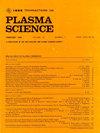不同液面高度的新型液态金属限流器限流特性研究
IF 1.5
4区 物理与天体物理
Q3 PHYSICS, FLUIDS & PLASMAS
引用次数: 0
摘要
液态金属限流器(LMCL)具有结构简单、自动限流等优点。限制电力系统短路电流已成为一项新的技术。为了提高传统绝缘隔板LMCL (ILMCL)的性能,设计了一种电阻隔板LMCL (RLMCL)。具体而言,对液态金属液柱模型的受力进行了计算,阐明了液态金属自收缩的运动机理;此外,还建立了液态金属自收缩效应的数学模型。利用Fluent仿真软件,得到了液态金属自收缩气液两相的动态图。最后,通过实验对比分析了不同金属液面高度下RLMCL的限流特性和电弧等离子体动态过程。结果表明,液态金属液面高度是影响液态金属自收缩速度的关键因素。液态金属是否填充通孔将改变液态金属的收缩方式。在相同电流作用下,随着液态金属液面高度的增加,RLMCL的起动限流时间、液态金属自缩时间和电流半波时间增加,电弧峰值电压和电弧时间逐渐降低。本文章由计算机程序翻译,如有差异,请以英文原文为准。
Current Limiting Characteristics of the Novel Liquid Metal Current Limiter With Different Liquid Metal Level Heights
Liquid metal current limiter (LMCL) has the advantages of simple structure and automatic current limiting. It has become a new technology to limit short-circuit current in power system. In order to improve the performance of traditional insulation partition LMCL (ILMCL), a resistive partition LMCL (RLMCL) is designed. Specifically, the force on the liquid metal liquid column model is calculated, and the motion mechanism of the liquid metal self-shrink is clarified; furthermore, a mathematical model for the liquid metal self-shrink effect is established. Using the simulation software Fluent, the dynamic diagrams of liquid metal self-shrinking gas-liquid two-phase are obtained. Finally, the current limiting characteristics and the arc plasma dynamic process of the RLMCL with different liquid metal level heights are compared and analyzed by experiments. The results indicate that the liquid metal level height is a key factor affecting the liquid metal self-shrinking speed. Whether the liquid metal fills through-hole will change the way the liquid metal shrinks. Under the same current action, as the liquid metal level height increases, the starting current limiting time, liquid metal self-shrinking time, and current half-wave time of the RLMCL increase while the peak arc voltage and arcing time gradually decrease.
求助全文
通过发布文献求助,成功后即可免费获取论文全文。
去求助
来源期刊

IEEE Transactions on Plasma Science
物理-物理:流体与等离子体
CiteScore
3.00
自引率
20.00%
发文量
538
审稿时长
3.8 months
期刊介绍:
The scope covers all aspects of the theory and application of plasma science. It includes the following areas: magnetohydrodynamics; thermionics and plasma diodes; basic plasma phenomena; gaseous electronics; microwave/plasma interaction; electron, ion, and plasma sources; space plasmas; intense electron and ion beams; laser-plasma interactions; plasma diagnostics; plasma chemistry and processing; solid-state plasmas; plasma heating; plasma for controlled fusion research; high energy density plasmas; industrial/commercial applications of plasma physics; plasma waves and instabilities; and high power microwave and submillimeter wave generation.
 求助内容:
求助内容: 应助结果提醒方式:
应助结果提醒方式:


